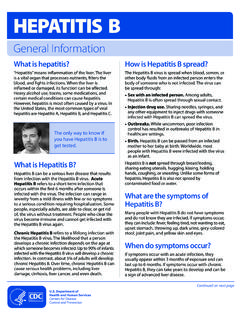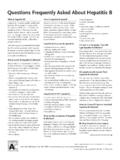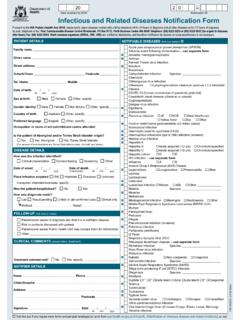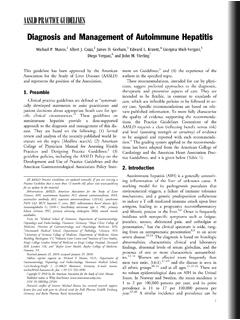Transcription of Hepatitis C in the UK 2020
1 Hepatitis C in the UK 2020. Working to eliminate Hepatitis C as a major public health threat 1. Hepatitis C in the UK 2020. Contents Foreword .. 3. Glossary of 5. Acknowledgements .. 6. Executive summary .. 8. Introduction .. 12. Burden of HCV 14. Monitoring service coverage .. 20. Adequate harm reduction .. 20. Increasing the proportion diagnosed .. 23. Increasing the numbers accessing Hepatitis C treatment .. 27. Monitoring impact .. 33. Reducing HCV-related morbidity and mortality .. 33. Reducing the incidence of HCV-related ESLD/HCC .. 33. Reducing deaths from HCV-related ESLD/HCC .. 39. Reducing the number of new (incident) infections .. 45. The Impact of COVID-19 on HCV elimination .. 52. Changes to service provision and access.. 52. HCV 52. Harm reduction services for people who inject drugs.
2 56. Initiatives in prisons .. 57. Treatment .. 57. Impact on data collection, surveillance, monitoring and evaluation .. 61. Impact on drug use behaviours, public health outcomes and longer-term service provision .. 61. Data sources .. 63. Appendices .. 65. Appendix 1. WHO GHSS targets for viral Hepatitis , relevant to HCV in the UK. context, with 2020 targets updated to reflect the draft action plan for the health sector response to viral Hepatitis in the WHO European Region .. 65. Appendix 2. Preliminary UK indicators to monitor the impact of key interventions to tackle Hepatitis C virus .. 67. 68. 2. Hepatitis C in the UK 2020. Foreword In the UK, an estimated 118,000 people are chronically infected with Hepatitis C (HCV), with many drawn from marginalised and underserved groups in society.
3 In this report, we review progress towards World Health Organization (WHO) elimination targets and highlight the important actions needed to reach them. In this period of pandemic, we have also included a preliminary assessment of the early impact of COVID-19 on Hepatitis services and monitoring in the UK. By 2019, substantial progress has been made towards the WHO elimination targets, with prevalence of HCV having fallen by around one third and deaths by 25%, when compared to the 2015 baseline, but challenges lie ahead. Collaborative work between UK public health services, the NHS, local authorities, primary care, pharmaceutical companies and the third sector continue to drive innovations that raise awareness, increase testing and improve pathways into care for target populations, thereby helping to reduce health inequalities.
4 Nonetheless, data presented in this report suggest that prevention activity may be failing to keep pace with the gains made in other areas. There is little evidence of any fall in the number of new infections in recent years. Injecting drug use is the main driver of HCV transmission in the UK, yet a significant minority of people who inject drugs (PWID) remain unaware of their HCV infections, needle and syringe provision is suboptimal and sharing injecting equipment remains of concern. As in many areas, the COVID-19 pandemic poses a serious threat to our ability to meet WHO HCV elimination goals, with latest data showing that HCV diagnosis and treatment fell dramatically during the early months of the pandemic. However, services have started to recover, and the pandemic response has undoubtedly driven some innovative models of service delivery.
5 Now, more than ever, it is essential that we do not lose focus on the important actions needed to reduce incidence, increase testing and improve linkage into care. We also need to work hard to ensure that services hit during the pandemic are adequately re- instated if we are to avoid increased inequalities in access to care and health outcomes. It has been remarkable to see how people working in the field of Hepatitis , at all levels and in all sectors, have worked so hard to keep Hepatitis services on track. I am sure that this same passion and commitment will stand us in good stead as we continue to drive towards our goal to eliminate HCV as a major public health threat in the UK by 2030. 3. Hepatitis C in the UK 2020. Professor Gwenda Hughes Deputy Director for Blood Safety, Hepatitis , Sexually Transmitted Infections and HIV.
6 Service National Infection Service 4. Hepatitis C in the UK 2020. Glossary of abbreviations BBV Blood-borne virus CI Confidence interval CrI Credible interval COVID-19 Coronavirus 2019. DAA Direct acting antiviral DBS Dried Blood Spot EPIToPe Evaluating the population impact of Hepatitis C direct acting antiviral treatment as prevention for people who inject drugs ESLD End-stage liver disease GHSS Global Health Sector Strategy HCC Hepatocellular carcinoma HCV Hepatitis C virus HES Hospital Episode Statistics HIS Hospital Inpatient System IEP Injection equipment provision NSP Needle and syringe programme NESI Needle Exchange Surveillance Initiative NWIS NHS Wales Informatics Service NIHR National Institute for Health Research NSGVH National Strategic Group on Viral Hepatitis ODN Operational Delivery Network OST Opioid substitution treatment PHA Public Health Agency PHE Public Health England PHS Public Health Scotland PWID People who inject drugs RCGP Royal College of
7 General Practitioners RNA Ribonucleic acid SHPN Scottish Health Protection Network SSBBV Sentinel surveillance of blood borne virus testing SGSS Second Generation Surveillance System SVR Sustained virological response UAM Unlinked Anonymous Monitoring Survey WHO World Health Organization 5. Hepatitis C in the UK 2020. Acknowledgements Contributors Annastella Costella, Sara Croxford, Claire Edmundson, Helen Harris (Editor), Ross Harris, Sema Mandal and Emily Phipps at Public Health England. Gillian Armstrong, Ruth Campbell, Annelies McCurley, Claire Neill, Gerry Waldron at the Public Health Agency Northern Ireland, and Siobhan Morgan and Stewart Dunbar at the Hospital Information Branch in the Department of Health Northern Ireland. David Goldberg, Sharon Hutchinson and Andrew McAuley at Public Health Scotland.
8 Noel Craine and Jane Salmon at Public Health Wales. Our thanks also go to Helen Bennett, Chris Biggam, Graham Foster, Rachel Giffen, Mark Gillyon-Powell, Rachel Halford, Jake Hall, Brendan Healy, Samreen Ijaz, William Irving, Philip Jordan, Arham Khawar, Freja Kirsebom, Galena Kuyumdzhieva, Conall McCaughey, Neil McDougall, Allan McLeod, Siew Lin Ngui, Danny Nicholson, Norah Palmateer, John Poh, Berry Puyk, Justin Shute, Ruth Simmons, Josie Smith, Shanley Smith, Steve Taylor, Drew Turner, Giri Shankar, Tatiana Vilaplana, Laura Walsh, Alison Watt, Amanda Weir, April Went and Alan Yeung for their contributions to the report. In England and Wales, we would like to thank the clinicians, microbiologists, public health practitioners and other colleagues who have contributed to the surveillance systems used in this report.
9 We would like to thank drug service staff who support, and participants in, the Unlinked Anonymous Monitoring (UAM) survey of people who inject drugs (PWID); Hospital Episode Statistics (HES), NHS Digital (NHS Digital is the trading name of the Health and Social Care Information Centre. Copyright 2020, re-used with the permission of NHS Digital. All rights reserved); NHS England for supplying treatment monitoring data for tax year 2015 to 2016 up to tax year 2020 to 2021 in England; the Office for National Statistics (ONS carried out the original collection and collation of the data but bears no responsibility for their future analysis or interpretation); and the NHS. Wales Informatics Service (NWIS). Retrospective testing of UAM survey data (2011 to 2016) and NESI survey (2011 to 2012, 2013 to 2014) for HCV ribonucleic acid (RNA).
10 And NESI 2019 to 2020 survey was funded as part of the Evaluating the population impact of Hepatitis C direct acting antiviral treatment as prevention for people who inject drugs' (EPIToPe) study, funded by the National Institute for Health Research (NIHR). Programme Grants for Applied Research programme (Grant Reference Number RP-PG- 0616-20008). The views expressed are those of the author(s) and not necessarily those of the NIHR or the Department of Health and Social Care. In Scotland, we would like to thank the blood-borne virus (BBV) co-ordinators in each NHS Board, the Hepatitis C Clinical Database Monitoring Committee, HCV testing laboratories and treatment centres, services providing injecting equipment, Glasgow 6. Hepatitis C in the UK 2020. Caledonian University, the West of Scotland Specialist Virology Centre and Scottish Government for their support and contributions to the surveillance systems used in this report.



















